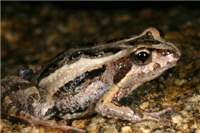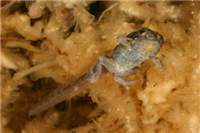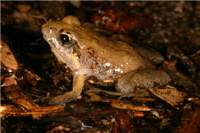Family
MyobatrachidaeGenus
CriniaSpecies
signiferaThreats/Control Methods - Regional
Despite C. signifera not currently being considered at risk, care should be taken at all times when entering frog habitats due to the risk of spreading disease, including the Chytrid fungus (chytridiomycosis). To prevent the spread of the Chytrid fungus it is important to wash your shoes before entering, AND after leaving frog habitats. For more information go to http://www.deh.gov/biodiversity/invasive/publications/c-disease/Local/Urban Actions
You can encourage frogs into your own backyard by including habitat features in your garden. The Ginninderra Catchment Group, Australian National University and Environment ACT have developed a guideline to help you encourage frogs into your backyard called Creating a Frog Friendly Habitat in the ACT Community.
You can also get involved in monitoring local frog populations. Frogwatch is an annual program run to monitor the presence and abundance of frogs within the ACT region. The Frogwatch program provides training for community volunteers each October, with monitoring then being undertaken by volunteers over a two week period.
For more information on Frogwatch contact:The ACT Frogwatch Coordinator, Ginninderra Catchment Group; Ph (02) 6278 3309 or email: [email protected]
Distinguishing Features
Adults grow to 2-3cm long; back colour and texture varies from greyish brown to reddish and from ridged to smooth; the belly is marked with black and white blotching; the hind legs are marked with dark bands, and dark triangular markings are found on the upper lips. The tadpoles vary in colouring, from sandy-gold to dark with lighter flecks. Eggs are found attached to vegetation or soil at the bottom of the waterbody.
Common name/s
Common Eastern Froglet, Common Froglet, Clicking Froglet, Signifera Froglet.
Similar Species
Crinia parinsignifera . The easiest way to identify the Common Eastern Froglet from similar species is by the mating call, described as a short repeated crick-crick-crick sound.
Distribution
Along the eastern edge of NSW and around the southern edge of Victoria, just crossing over into South Australia. Also found in northern Tasmania and small regions within QLD.
Country of Origin
Australia
Survey Techniques
The most common technique for monitoring frog populations is based on call identification, with each frog species having a unique call. Frogs should not be handled without the use of sterile gloves, as their skin is very sensitive to chemicals, including soap and sunscreen. For more information see Local Actions below.
Conservation (Pet/Pest) Status - National
Not at risk
Conservation (Pet/Pest) Status - Regional
Not at risk
LSCCES Population
C.signifera was detected in 69% of the 2004 ACT Frogwatch sites.
Associated Vegetation Community
Wet sclerophyll forests, grasslands and disturbed areas (such as farm dams or roadside ditches that hold water).
Limiting Resources
Tadpoles require water temperatures of 14-15©C to undergo metamorphosis.
Breeding
Eggs are laid in clumps of up to 250, with breeding occurring most of the year. Tadpoles are typically seen from late spring through summer.
Behaviour
Calls from January to June.
Functional Group
Insectivorous
Food Species
Small invertebrates such as beetles (Coloeptera), spiders (Arachnida), and centipedes (Chilopoda).
Predators
May include native birds, such as the White-Faced Heron (Egretta novaehollandiae) and Intermediate Egret, and fish, including the introduced Carp, Goldfish and Trout. Introduced species such as Cats (Felis catus) and Foxes may also predate on frogs.
Interesting Fact
This little frog has been known by many names and has undergone several name changes over the last 150 years. Previous aliases include Cystignathus sydneyensis, Camariolus pictus and Crinia affinis halmaturina.
References - (reader suitability of references, P=Primary teachers, S=Secondary students, T=Tertiary students and researchers)
Books:
Barker, J., Grigg,G., Tyler, M. (1995). A Field Guide to Australian Frogs. Surry Beatty & Sons. NSW, Australia. S, TLintermans,M. & Osborne, W. (2002). Wet & Wild: A Field Guide to the Freshwater Animals of the Southern Tablelands and High Country of the ACT and NSW. Environment ACT. Canberra, Australia. P, S, TRobinson, M. (1993). A Field Guide to Frogs of Australia. Australian Museum/Reed books. NSW, Australia. S, TTurner, J. (2004). Frogs of Australia. Pensoft. Bulgaria. S, TTyler, J. (1994). Australian Frogs: A Natural History. Reed New Holland. Australia. S, TSwan, G.(2001). Green Guide: Frogs of Australia. New Holland Publishers. Sydney, Australia. P, S
Online Publications:
Amphibian Research Centre. (2005). Crinia parinsignifera . Available Online: http://frogs.org.au/frogs/species/Crinia/parinsignifera/Australian Frogs Database. (2005). Crinia parinsignifera . Available Online: http://frogsaustralia.net.au/frogs/display.cfm?frog_id=10Department of Environment and Heritage, (2004). Chytridiomycosis Factsheet http://www.deh.gov.au/biodiversity/invasive/publications/c-disease/ S, TZoological Parks and Gardens Board. Frog Pond Checklist. Available Online: http://www.zoo.org.au/education/factsheets/amp-frog_pond_checklist.pdfZoological Parks Board N>S>W. (2005.). ASX Frog Focus. Available online: http://www.asxfrogfocus.com/ P, S (School activity program)Speare, R et al (1998). HOW TO REDUCE THE RISKS OF YOU TRANSMITTING AN INFECTIOUS AGENT BETWEEN FROGS AND BETWEEN SITES. Available Online: http://www.jcu.edu.au/school/phtm/PHTM/frogs/prevent.htm S, T
Researcher: Pippa Jaminon



 Top
Top Top
Top